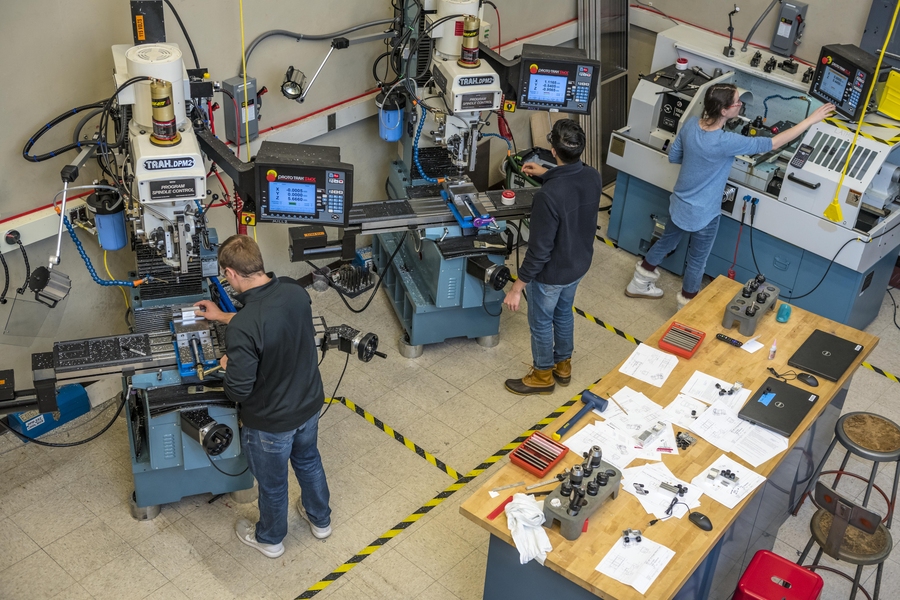A reformed workforce education system might be the key to reversing growing income inequality, according to a new report from the MIT Open Learning Workforce Education Project.
Led by Vice President for Open Learning Sanjay Sarma and Senior Director of Special Projects William Bonvillian, the Workforce Education Project is a research effort to study the workforce education landscape in the United States. Meghan Perdue from MIT Open Learning and the MIT Sloan School of Management’s Jenna Myers co-led the project, which received foundation support from Schmidt Futures. The preliminary report — a second, more detailed report will follow — examines the problems in the current U.S. workforce education system, including disinvestment from the government and employers, as well as a lack of coordination across existing programs, and suggests new models for meeting 21st-century workforce needs. The report also includes working papers that provide backup studies to these findings.
The need to train and upskill American workers will only grow as the country and the world continues to grapple with the effects of Covid-19. The pandemic has impacted every aspect of life for individuals and communities across the United States and the world, and will have far-reaching consequences for the economy, education, and work. It has underscored economic inequality, raised new discussions about what defines an essential worker, and — in a very short time — changed what was considered possible for remote learning and work. Key sectors facing critical transformations in the current crisis, including manufacturing and education, are a focus of the Workforce Education Report, and the coronavirus has sharply accelerated evolutions already underway in each. New sets of workforce skills will be required as a result of these changes; the authors of the report believe that the post-pandemic world will reinforce the challenges and potential solutions identified by their research.
Reforming workforce education
As cited in the report, the chief factor that has contributed to America’s economic inequality is the decline of manufacturing jobs. Between 2000 and 2011, the United States lost a third, or 5.8 million, of its manufacturing jobs. This has closed off a major route to the middle class for those with a high school education or less. “At the same time, the overall workforce is up-skilling as new technologies incrementally enter the economy,” the authors add, noting that quality jobs tend to go to those with college educations.
But a strong 21st-century skills training system could close this education divide, giving workers the education and opportunities to move into better paying jobs requiring higher skill levels. While colleges and universities have long been considered “largely divorced from the workforce fray,” the Workforce Education Project finds that higher education institutions can, in fact, play a significant role in reforming workforce education. Universities are well-positioned to organize new kinds of delivery mechanisms across secondary schools, community colleges, and other four-year institutions of higher education. They also have the resources to invest in learning science research and develop optimal teaching approaches, making them indispensable to the development of lifelong learning systems.
The Covid-19 pandemic has forced a massive education experiment: nearly all teaching and learning in America, from K-12 through higher ed, shifted online in the space of a few weeks, and for an indefinite period of time. While this unprecedented moment has presented serious challenges, from outdated technology to mediocre material, the simple fact that instruction has been able to continue is a hopeful sign.
“Online education has been shown to be our resilient system — there is no substitute now for it,” says Bill Bonvillian. “The coronavirus has given us an opportunity to optimize.” As different sectors begin to grapple with the long-term ramifications of the current crisis, the possibility of enhancing and diversifying workforce skills through remote learning options remains a stabilizing constant — and the need for more robust and coordinated efforts is greater than ever.
High schools and community colleges may provide new models
New models coming from community colleges could play a key role. For example, the report examines a Connecticut school that uses its high-tech manufacturing center not only to train community college students but area incumbent workers and high school students as well, and a Florida school that has developed a short-term certificate program that quickly moves workers from lower-end services jobs into much better-paying higher skilled jobs.
The Workforce Education Report also examines the possibility of apprenticeships to “create a direct line between the stovepipes of education and work,” particularly for high school and community college students. The success of apprenticeship programs in states like Kentucky, Michigan, North Carolina, Wisconsin, and South Carolina indicates that close collaboration between employers, educators, and the government is crucial to making apprenticeships work in the United States.
Bonvillian notes that “The American dream promised if you worked hard you could move up into the middle class. That’s a lot less true today. A new workforce education system, which we’ve tried to outline here, is a critical step in restoring that dream.”
With many stakeholders and moving parts, the report concludes, the scale of the workforce education task is immense. However, new technologies and advances in online education — including much of what Open Learning has been developing in recent years, like MITx courses, MicroMasters and other microcredential certificate programs, MIT Bootcamps, and xPRO courses developed with employers — make now the ideal time to begin the work of giving the workforce more agile options.
Sarma adds, “New online technologies and the new learning science that goes with them let us reimagine workforce education. They can help us democratize education, and workforce training is a leading candidate for change.”









